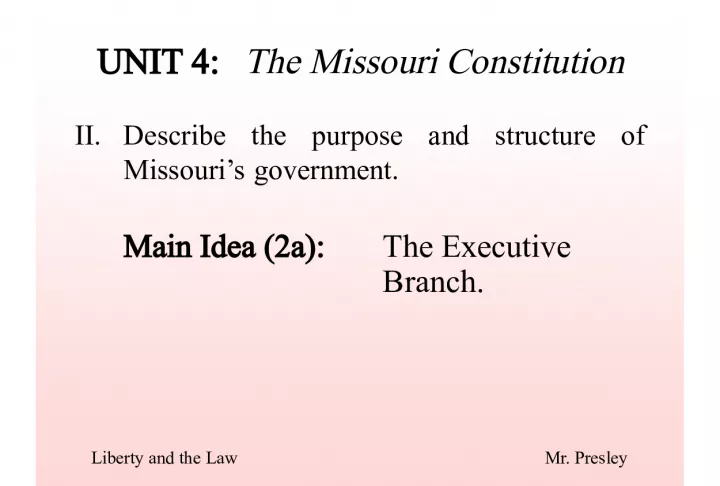Understanding the Executive Branch of Missouri's Government


This section focuses on providing a comprehensive overview of the purpose and structure of Missouri's government, with a specific emphasis on the executive branch. Article II of the Missouri Constitution outlines the three branches
- Uploaded on | 2 Views
-
 cindy
cindy
About Understanding the Executive Branch of Missouri's Government
PowerPoint presentation about 'Understanding the Executive Branch of Missouri's Government'. This presentation describes the topic on This section focuses on providing a comprehensive overview of the purpose and structure of Missouri's government, with a specific emphasis on the executive branch. Article II of the Missouri Constitution outlines the three branches. The key topics included in this slideshow are . Download this presentation absolutely free.
Presentation Transcript
Slide1II.Describe the purpose and structure of Missouri’s government. Main Idea (2a): The Executive Branch. UNIT 4: The Missouri Constitution Liberty and the Law Mr. Presley
Slide2A. MAIN IDEA - The Executive Branch Article II of the Missouri Constitution establishes the three branches of government that denotes a separation of powers: the main job of the executive branch is to carry out the laws, the legislative branch makes the laws, and the judicial branch interprets the laws. Article IV of the Missouri Constitution establishes the executive branch, which has the powers to make rules and decisions that affect the citizens’ lives, with powers to act.
Slide3Missouri has six elected executive officials, with over 350 boards and commissions with certain and unique powers granted to them. The seat of Missouri government is located at the state’s capital - Jefferson City . There are fourteen departments created to make rules or recommend action on special subjects. The revenue department handles licenses and renewals, as well as taxes. The transportation department (MODOT) deal with bridges and roads. Public safety operates rules and regulation for police agencies and directs the highway patrol.
Slide4The elementary and secondary education department (DESE) oversees teacher certification, accreditation status, and budget distributions. The natural resources and conservation department deal with rivers, mining, atmosphere, soil, wildlife, and pollution management. Others include consumer affairs, social services, and agriculture.
Slide5The governor is the chief executive of the state. The governor must meet the following qualifications - 30 years old, US citizen for 15 years, and lived in the state for 10 years. The governor is elected by the popular vote for four years. Like other elected officials, a special commission of judges appointed by the senate may impeach the governor. Powers - Administers laws, appoints and removes officials, recommends laws and budgets, acts as liaison with federal government, signs or vetoes bills, calls special sessions, commands the National Guard, acts as ceremonial head of state, and grants pardons, reprieves, or commutation.
Slide6Other members of the executive branch are elected as well. The lieutenant governor is the president of the state Senate, serves as governor if the elected governor leaves office, and must meet the same qualifications as the governor. Secretary of state is the non-financial record keeper, which includes preparation of voting ballots and certifies elections. The attorney general is the chief legal officer that prosecutes and defends in state cases. The treasurer is the chief financial officer that cares for and invests state funds. The auditor checks collection and spending of money by all state agencies, approves depositories, and sets up accounting system for state and local governments.
Slide7STATE GOVERNORGrants pardons, reprieves, or commutations. Enforces and administers the laws. Veto bills, line-item vetoes, or sign bills into law. Commands the National Guard. Appoints and removes officials.